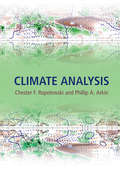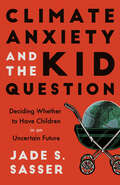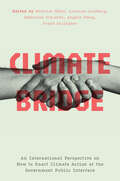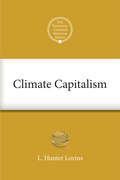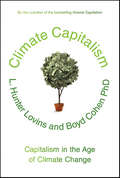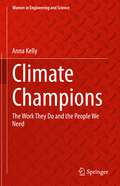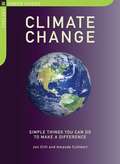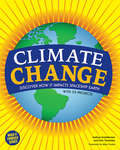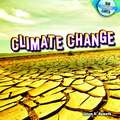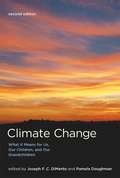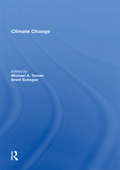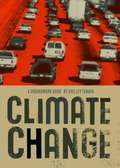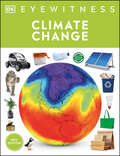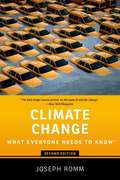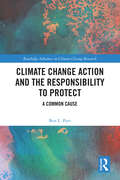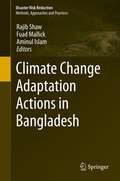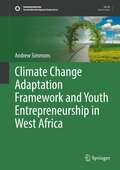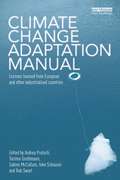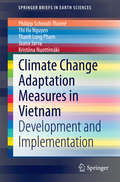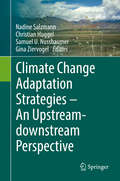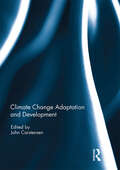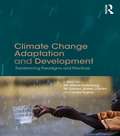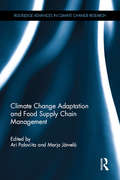- Table View
- List View
Climate Analysis
by Chester F. Ropelewski Phillip A. Arkin SrSensational images and stories about variations in Earth's climate and their impacts on society are pervasive in the media. The scientific basis for these stories is often not understood by the general public, nor even by those with a scientific background in fields other than climate science. This book is a comprehensive resource that will enable the reader to understand and appreciate the significance of the flood of climate information. It is an excellent non-mathematical resource for learning the fundamentals of climate analysis, as well as a reference for non-climate experts that need to use climate information and data. The focus is on the basics of the climate system, how climate is observed and how the observations are transformed into datasets useful for monitoring the climate. Each chapter contains Discussion Questions. This is an invaluable textbook on climate analysis for advanced students, and a reference textbook for researchers and practitioners.
Climate Anxiety and the Kid Question: Deciding Whether to Have Children in an Uncertain Future
by Jade SasserThe first book-length exploration of climate-driven reproductive anxiety that places race and social justice at the center. Eco-anxiety. Climate guilt. Pre-traumatic stress disorder. Solastalgia. The study of environmental emotions and related mental health impacts is a rapidly growing field, but most researchers overlook a closely related concern: reproductive anxiety. Climate Anxiety and the Kid Question is the first comprehensive study of how environmental emotions influence whether, when, and why people today decide to become parents—or not. Jade S. Sasser argues that we can and should continue to create the families we desire, but that doing so equitably will require deep commitments to social, reproductive, and climate justice. Climate Anxiety and the Kid Question presents original research, drawing from in-depth interviews and national survey results that analyze the role of race in environmental emotions and the reproductive plans young people are making as a result. Sasser concludes that climate emotions and climate justice are inseparable, and that culturally appropriate mental and emotional health services are a necessary component to ensure climate justice for vulnerable communities.
Climate Bridge: An International Perspective on How to Enact Climate Action at the Government Public Interface
by Laurel V. HankinsClimate change is creating new challenges for spatial and environmental planning on both sides of the Atlantic. Planning and policy must balance moderating climate change impact from rising temperatures, extreme precipitation, and sea level rise with social equity and environmental justice. Climate Bridge compares New Jersey and the German Ruhr region to build an international perspective on how to enact climate action at the government-public interface. The book grew from fifteen years of collaboration between scholars in New Jersey and Germany through summer programs, a landscape architecture design studio, internships for Rutgers University students, and joint publications. Notably, settlement patterns and brownfield issues reveal similarities between the underserved in both regions. The first section compares international environmental planning approaches and outlines different approaches to common problems. The second section presents case studies that highlight adaptation strategies for uncertainties caused by climate change. Finally, the closing section reminds us of our dependence on ecological systems for physical, mental, and emotional well-being. Contributors to this landmark volume include planners, designers, scholars, public administrators, and decision-makers on both sides of the Atlantic. Together, the chapters bring interdisciplinary approaches and diverse perspectives to the environmental, economic, political, and social dimensions of planning and design in the context of climate change.
Climate Capitalism
by L. Hunter Lovins Eban GoodsteinOn October 5, 2011, L. Hunter Lovins participated in The National Climate Seminar, a series of webinars sponsored by Bard College's Center for Environmental Policy. The online seminars provide a forum for leading scientists, writers, and other experts to talk about critical issues regarding climate change. The series also opens a public conversation, inviting participants to ask questions and contribute their own thoughts. Lovins is President and founder of Natural Capitalism Solutions (NCS / www.natcapsolutions.org). NCS works with businesses, governments, and civil society to develop practices that are sustainable for both people and the environment. Her lecture focused on ways that the United States can pull itself out of the current recession, while preserving natural and human capital. This E-ssentialis an edited version of Lovins' talk and the subsequent question and answer session. While some material has been cut and some language modified for clarity, the intention was to retain the substance of the original discussion.
Climate Capitalism
by Peter Newell Matthew PatersonConfronting climate change is now understood as a problem of 'decarbonising' the global economy: ending our dependence on carbon-based fossil fuels. This book explores whether such a transformation is underway, how it might be accelerated, and the complex politics of this process. Given the dominance of global capitalism and free-market ideologies, decarbonisation is dependent on creating carbon markets and engaging powerful actors in the world of business and finance. Climate Capitalism assesses the huge political dilemmas this poses, and the need to challenge the entrenched power of many corporations, the culture of energy use, and global inequalities in energy consumption. Climate Capitalism is essential reading for anyone wanting to better understand the challenge we face. It will also inform a range of student courses in environmental studies, development studies, international relations, and business programmes.
Climate Capitalism: Capitalism in the Age of Climate Change
by L. Hunter Lovins Boyd CohenBelieve in climate change. Or don't. It doesn't matter. But you'd better understand this: the best route to rebuilding our economy, our cities, and our job markets, as well as assuring national security, is doing precisely what you would do if you were scared to death about climate change. Whether you're the head of a household or the CEO of a multinational corporation, embracing efficiency, innovation, renewables, carbon markets, and new technologies is the smartest decision you can make. It's the most profitable, too. And, oh yes—you'll help save the planet. In Climate Capitalism, L. Hunter Lovins, coauthor of the bestselling Natural Capitalism, and the sustainability expert Boyd Cohen prove that the future of capitalism in a recession-riddled, carbon-constrained world will be built on innovations that cutting-edge leaders are bringing to the market today. These companies are creating jobs and driving innovation. Climate Capitalism delivers hundreds of indepth case studies of international corporations, small businesses, NGOs, and municipalities to prove that energy efficiency and renewable resources are already driving prosperity. While highlighting business opportunities across a range of sectors—including energy, construction, transportation, and agriculture technologies—Lovins and Cohen also show why the ex–CIA director Jim Woolsey drives a solar-powered plugin hybrid vehicle. His bumper sticker says it all: "Osama bin Laden hates my car." Corporate executives, entrepreneurs, environmentalists, and concerned citizens alike will find profitable ideas within these pages. In ten information-packed chapters, Climate Capitalism gives tangible examples of early adopters across the globe who see that the low-carbon economy leads to increased profits and economic growth. It offers a clear and concise road map to the new energy economy and a cooler planet.
Climate Champions: The Work They Do and the People We Need (Women in Engineering and Science)
by Anna KellyIn this groundbreaking work, readers will discover a wealth of innovative and impactful advancements in the field of climate change. A call to action for those working to arrest or mitigate the impacts of this global crisis, this book showcases the tireless dedication of a workforce committed to creating a better world. Despite the despair and anger that often accompany discussions of climate change, this book offers a refreshing perspective by highlighting the moments of hope and pride that arise when individuals see their efforts have tangible, measurable impacts. Readers will also be inspired to learn that they don't have to be scientists or engineers to make a difference. The author illustrates how every person with an interest in protecting the environment, the global food supply, and geopolitical stability can join the fight, whether by improving the efficiency of manufacturing operations or by contributing to the manufacture of life-saving medicines. This is a must-read for anyone who cares about the environment, our global community, and our collective future.
Climate Change
by Jon Clift Amanda CuthbertYou know that the ice caps are melting, the seasons are changing, sea levels are rising, storms are on the increase, but what can you do about it? Plenty! This book puts the power back into your hands in the face of the doom and gloom of climate change. You don't have to wait for someone else to sort it out; rather than worry and feel helpless, you can get up and do something. "Climate Change: Simple Things You Can Do to Make a Difference" is packed with ideas for action, from simple everyday things that cost nothing to bigger projects that involve more time and money. For example: Get on your bike bull; Buy local food bull; Turn off your TV bull; Insulate your attic bull; Recycle and compost bull; Take the train bull; Turn down the heat bull; Install solar panels Do your part and protect the planet for today and tomorrow.
Climate Change
by Joshua Sneideman Erin TwamleyFor more than 200 years, scientists have been observing, measuring, and analyzing information about our planet’s climate. Studies show that the earth is in constant transition and humans have an effect on what happens. In Climate Change: Discover How It Impacts Spaceship Earth, young readers examine real studies concerning planetary science, Arctic ice bubbles, and migratory patterns. Kids explore the history of human impact from the Industrial Revolution to our modern-day technology, as well as the innovations underway around the world to address global climate change. The idea of climate change can be scary, but every one of us has the ability to make a difference. Focused on a pro-active approach to environmental education, Climate Change engages readers through hands-on activities and helps kids deconstruct myths about our changing world. Kids are directed to digital supplemental material that makes complex concepts easier to understand through visual representation. Climate Change offers a myriad of ways to think of our Spaceship Earth as the singular resource it is. Climate Change meets Common Core State Standards for literacy in science and technology; Guided Reading Levels and Lexile measurements indicate grade level and text complexity.
Climate Change
by Jason D. NemethOur home planet's climate has gone through tremendous changes during its history. This fascinating book discusses these changes, explains the processes that drove them, and describes the methods scientists use to learn about the history of Earth's climate. The volume also addresses the kinds of climate changes happening today and clarifies how these differ from changes that occurred in the past. The book's easy-to-follow language will make this complex topic easy for young readers to digest.
Climate Change
by Jonathan CowieThe second edition of this acclaimed text has been fully updated and substantially expanded to include the considerable developments (since publication of the first edition) in our understanding of the science of climate change, its impacts on biological and human systems, and developments in climate policy. Written in an accessible style, it provides a broad review of past, present and likely future climate change from the viewpoints of biology, ecology, human ecology and Earth system science. It will again prove to be invaluable to a wide range of readers, from students in the life sciences who need a brief overview of the basics of climate science, to atmospheric science, geography, geoscience and environmental science students who need to understand the biological and human ecological implications of climate change. It is also a valuable reference text for those involved in environmental monitoring, conservation and policy-making.
Climate Change
by Pamela Doughman Joseph F.C. DiMentoMost of us are familiar with the term climate change but few of us understand the science behind it. We don't fully comprehend how climate change will affect us, and for that reason we might not consider it as pressing a concern as, say, housing prices or unemployment. This book explains the scientific knowledge about global climate change clearly and concisely in engaging, nontechnical language, describes how it will affect all of us, and suggests how government, business, and citizens can take action against it. This completely revised and updated edition incorporates the latest scientific research and policy initiatives on climate change. It describes recent major legislative actions, analyzes alternative regulatory tools including new uses of taxes and markets, offers increased coverage of China and other developing nations, discusses the role of social media in communicating about climate change, and provides updated assessments of the effects of climate change. The book first explains the basic scientific facts about climate change and its global impact. It discusses the nature of scientific consensus and the strong consensus of mainstream science on climate change. It then explores policy responses and corporate actions in the United States and the rest of the world, discusses how the communication of climate change information by journalists and others can be improved, and addresses issues of environmental justice -- how climate change affects the most vulnerable populations and regions. We can better tackle climate change, this book shows us, if we understand it.
Climate Change
by Michael A. TomanOver the years, a large and growing literature on the economics of climate change has developed. Within this volume the contributors have included a wide range of journal essays that consider the impact of climate change on specific sectors; goods and services; the costs and benefits of greenhouse gas (GHG) mitigation; and policy design for mitigation, including both domestic instruments and issues related to international agreements.
Climate Change
by Shelley TanakaScientists have been warning the world about global warming for almost three decade. But the rest of us are only now starting to get the message. The planet is warming at an unusually rapid rate, and this warming is largely being caused by human activity. Shrinking glaciers, thawing permafrost, erratic weather and threatened freshwater supplies are already affecting the lives of people around the globe, and the worst is still to come. The crisis is real, but there is little consensus about how to confront the problem, not only because the science is complex, but because the economic, political and social implications of taking action are vast, far-reaching and unsettling.
Climate Change (DK Eyewitness)
by John Woodward DKBecome an eyewitness to the world&’s climate emergency and learn what we can do about it.Get the facts about how our planet&’s climate is changing and what the consequences will be. This essential guide explores Earth&’s climate, past and present, giving you the facts and figures behind one of today&’s most urgent issues, and investigates what we can all do to make a difference.DK Eyewitness Climate Change explains why human activities are making the planet heat up –and how we know for sure that this is the case. This global warming book explores the effects of the changing climate, from more frequent hurricanes and wildfires to melting ice caps and rising sea levels. It shows how scientists predict how the climate will change in the future, and what actions we can all take to combat climate change.Loved and trusted for over 30 years, Eyewitness has a new look and even more content:• A bite-sized formula of text with images that kids love!• Fully revised and fact-checked by subject specialists• Packed with facts, infographics, statistics, and timelines• Updated with brand new eyewitness accounts from experts in the fieldEyewitness Climate Change uses a groundbreaking visual layout that makes learning fun for kids aged 9-12. Packed with photographs, facts, and statistics that offer a unique &“eyewitness&” view of the dramatic changes that are affecting the weather, the environment, and the way we lead our lives.Eyewitness content approved by -ologists!DK&’s Eyewitness kids books are updated and fact-checked by subject specialists, with brand new first-hand eyewitness accounts throughout from experts in the field. A best-selling series known and trusted for generations, with a fresh new look and up-to-date content. What will you Eyewitness next?Discover more about the world&’s most extreme weather phenomena with Eyewitness Hurricane & Tornado or dive deep into the ocean with some of the most amazing sea creatures with Eyewitness Ocean. Do you think you&’ve found your topic of interest? DK has even more climate change books for kids and adults alike find them all by searching for &“DK climate change books&”.
Climate Change (What everyone needs to Know)
by Joseph RommThe essential primer on what will be the defining issue of our time, Climate Change: What Everyone Needs to Know is a clear eyed overview of the science, conflicts, and implications of our warming planet. <p><p> From Joseph Romm, Chief Science Advisor for National Geographic's Years of Living Dangerously series and one of Rolling Stone's "100 people who are changing America," Climate Change offers user friendly, scientifically rigorous answers to the most difficult (and commonly politicized) questions surrounding what climatologist Lonnie Thompson has deemed "a clear and present danger to civilization." <p> New questions about climate change addressed in this guide include: <p> · Analysis of the Paris climate agreement, including the United States' withdrawal <p> · Examines implications of the clean energy revolution, from solar and wind power to batteries and electric cars <p> · The latest on climate science, including updates on efforts to stem or slow climate change <p> · Insights into what Donald Trump's presidency means for climate action in the US and internationally <p> As the global response to climate change continues to evolve, Climate Change: What Everyone Needs to Know offers smart, unbiased answers to the most difficult questions in an area dogged by misunderstanding and politicization.
Climate Change Action and the Responsibility to Protect: A Common Cause (Routledge Advances in Climate Change Research)
by Ben L. ParrThis book brings together two important fields in the study of international politics and policy: climate change adaptation and mitigation (climate action) and the Responsibility to Protect (R2P). Both have attracted strong scholarly attention in each of their respective research silos, but there is yet to be a strong research push that explores the relationship between the two. Filling this gap, Ben L. Parr argues that the climate action and the R2P agendas share a common goal: to protect vulnerable human populations from large-scale harm. To substantiate this argument, Parr reveals where the historical, conceptual, and operational parallels exist between the two agendas, and where and when researchers and practitioners from both camps might work together in practice to achieve their common goal in the challenging years ahead. Notably, the book builds on recent efforts by Western governments in the UK, US, and EU to integrate climate action policies into conflict prevention and response policies. To achieve this, the volume situates a variety of climate action policies alongside the 46 policy options found in the R2P operational framework (commonly known as the R2P toolbox) across its prevention, reaction, and rebuilding phases. Climate Change Action and the Responsibility to Protect will be of significant interest to policy-orientated students and scholars, those working at the academic-policy interface in the NGO community, as well as those working in government and international organisations.
Climate Change Adaptation Actions in Bangladesh (Disaster Risk Reduction)
by Rajib Shaw Aminul Islam Fuad MallickThe book outlines the climate change adaptation (CCA) actions in Bangladesh drawing examples and lessons from different projects and programs in the country. The content is based on a selection of available documents, a consultative workshop with the academicians from different universities undertaking higher education on disaster risk reduction and climate change adaptation, and the editors' own knowledge and experience in the field. The book has four parts. Part I gives the details of climate change impacts, providing the scenarios, negotiations, and specific impacts on sea-level rise and the health sectors. Part II focuses on climate change strategy and action plans. Part III covers socio-economic impacts in terms of economic and environmental costs. Part IV focuses on adaptive actions for agriculture, livelihoods, and integrated approaches in agriculture and fisheries. Part V deals with climate-change governance issues. The primary target groups for this book are students and researchers in the fields of environment, disaster risk reduction, and climate change studies. The book will provide them with a good idea of the current trend of research in the field and will furnish basic knowledge on this important topic in Bangladesh. Another target group comprises practitioners and policy makers, who will be able to apply collective knowledge to policy and decision making.
Climate Change Adaptation Framework and Youth Entrepreneurship in West Africa (Sustainable Development Goals Series)
by Andrew SimmonsThis book's purpose is to highlight the development challenges and successes of implementing the Youth Climate Change Adaptation Development Framework in Sierra Leone, West Africa. Over the past decade, Sierra Leone has experienced a series of development challenges, including internal conflict and Ebola outbreaks in most recent times. The dire unemployment situation in Sierra Leone is compounded by the emergence of climate change that negatively impacts all aspects of daily life and wellbeing, and the education and training provided do not prepare young people adequately for the job market. Therefore, building youth resilience to adapt to the impact of climate change and other development problems is a significant development challenge faced by policymakers in Sierra Leone. The government, through funding from the African Development Bank (AfDB), has provided support for the implementation of a Youth Employment and Entrepreneurship Project (YEEP) to reinforce the employability of Sierra Leone Youth as well as enhance their entrepreneurship and employment skills through the development of a framework that integrates education and vocational institutions with job market demand and supply. This approach has resulted in strengthening the occupational levels in the youth population segments of the country. This book discusses the objectives and outcomes of this project, including curricula for Sustainable Construction, training of counselors and administrators, providing youths with supervisory skills, and developing tools to assess youth development institutions' weaknesses and enhance institutional capacity to deliver climate change adaption for sustainable development programmes. The book can be used by policymakers from Small Island Developing States (SIDS) and LDCs in Africa and Asia. It can be used by researchers working on Climate Change, Education, Sustainable Development, emphasising Climate Change Education for Sustainable Development in both developing and developed countries. It can also be used by practitioners involved in implementing innovations in youth development, employment, entrepreneurship, sustainable livelihoods initiatives, climate change adaptation, and mitigation. These practitioners and researchers would find this book an invaluable resource to support their work in the field.
Climate Change Adaptation Manual: Lessons learned from European and other industrialised countries
by Rob Swart Andrea Prutsch Torsten Grothmann Sabine McCallum Inke SchauserDue to the lack of success in climate change mitigation efforts, the importance of adaptation is becoming more and more apparent and is now one of the main imperatives of international research and action. However, research on adaptation is mostly not directly applicable to adaptation policy or practice, leaving a gap between scientific results and practical advice for decision makers and planners. This book seeks to address this problem and bridge the gap and should provide readers with practical and applicable information on climate change adaptation. Following an introduction, the book is organised into four main sections, each reflecting an essential component in the adaptation process. Climate change adaptation is an emerging subject area and has gained increased political and academic attention within the last decade. Whereas most books in the field focus on adaptation in developing countries, this volume provides an examination of predominantly European policy and offers inter-disciplinary insight into cutting edge knowledge and lessons learnt in a relatively new field of implementation.
Climate Change Adaptation Measures in Vietnam: Development and Implementation (SpringerBriefs in Earth Sciences)
by Philipp Schmidt-Thomé Thi Ha Nguyen Thanh Long Pham Jaana Jarva Kristiina NuottimäkiThis book describes the iterative steps that were successfully undertaken to develop adaptation measures to climate change in two Vietnamese provinces. The methodology used to develop the scientific basis and the societal agreement of the need to adapt to climate change is applicable also to other regions in Vietnam, Asia and worldwide. The uncertainties of climate change models make it difficult to justify investments to finance protection from uncertain impacts. Setting out with the projected climate change impacts in Vietnam, which is one of the most vulnerable countries to climate change, the book describes a methodological approach to assess and evaluate local vulnerabilities of natural resources to climate change and socio-economic impacts, engaging local stakeholders in the development of locally acceptable and economically feasible adaptation measures. The methodological approach to understand the vulnerabilities and to develop climate change adaptation measures was scenario workshops that supported the communication between scientists and stakeholders. The development of climate change adaptation strategies is nearly state-of-the-art in many countries, but often there is still a large step towards implementing climate change adaptation measures on the local level. The challenge in the development of adaptation measures lies in their acceptability by local stakeholders and decision makers. Climate change adaptation measures also usually demand investments. To understand potential future risks the communication methodology was to first get a good understanding of the natural resources (mainly surface and groundwater) and their potential vulnerabilities (current and future). This was followed by developing a common understanding of current risk patterns, as well as underlying vulnerabilities and hazards. Socio-economic developments have an equally strong, and in the short term mostly even stronger, impact on the living environment and natural resources as long-term climate change impacts. The scenario workshops developed a holistic approach on current and potential future risk patterns, with a special focus on surface and groundwater quantities and qualities, natural hazards and sea level rise. Land-use planning was identified as playing a decisive role in minimizing current and future risks. Finally, first adaptation measures for two Vietnamese provinces were developed and shall be implemented over the next years. The methodology that led to these adaptation measures shall be applied in other Vietnamese provinces.
Climate Change Adaptation Strategies – An Upstream-downstream Perspective: An Upstream-downstream Perspective
by Christian Huggel Nadine Salzmann Samuel U. Nussbaumer Gina ZiervogelClimate change and the related adverse impacts are among the greatest challenges facing humankind during the coming decades. Even with a significant reduction of anthropogenic greenhouse gas emissions, it will be inevitable for societies to adapt to new climatic conditions and associated impacts and risks. This book offers insights to first experiences of developing and implementing adaptation measures, with a particular focus on mountain environments and the adjacent downstream areas. It provides a comprehensive 'state-of-the-art' of climate change adaptation in these areas through the collection and evaluation of knowledge from several local and regional case studies and by offering new expertise and insights at the global level. As such, the book is an important source for scientists, practitioners and decision makers alike, who are working in the field of climate change adaptation and towards sustainable development in the sense of the Paris Agreement and the Agenda 2030.
Climate Change Adaptation and Development
by John CarstensenClimate change is real and it is man-made. We have put so many greenhouse gas pollutants into the atmosphere that we will see significant and long-term change that we need to adapt and adjust to. It is important for development practitioners to understand these impacts and the challenge of how and when to adapt to climate change.There are plenty of grim presentations of what the extremes of the possible climate scenarios will throw at us over the next 100 years, but not all change will be disastrous; some change will be beneficial, but much of the change will happen at an unprecedented rate that will require the best possible analysis and understanding of how and when we should adapt to climate change.This is important for development practitioners as we invest in ensuring that poverty is reduced and eliminated and the well-being of everyone is improved. Many countries and communities around the world are vulnerable to the impacts of climate change, but developing economies may on one hand be less resilient to the impact, but could on the other hand be in a better position to make their development climate smart by making the most efficient use of their economic resources.The chapters in this book shine a light on the complexity and the multi-dimensional aspects of climate change adaptation. They gather some of the experiences of addressing climate change impacts in a development context. This book was previously published as a special issue of Development in Practice.
Climate Change Adaptation and Development: Transforming Paradigms and Practices (Climate And Development Ser.)
by Karen O'Brien Tor Håkon Inderberg Siri Eriksen Linda SygnaClimate change poses multiple challenges to development. It affects lives and livelihoods, infrastructure and institutions, as well as beliefs, cultures and identities. There is a growing recognition that the social dimensions of vulnerability and adaptation now need to move to the forefront of development policies and practices. This book presents case studies showing that climate change is as much a problem of development as for development, with many of the risks closely linked to past, present and future development pathways. Development policies and practices can play a key role in addressing climate change, but it is critical to question to what extent such actions and interventions reproduce, rather than address, the social and political structures and development pathways driving vulnerability. The chapters emphasise that adaptation is about much more than a set of projects or interventions to reduce specific impacts of climate change; it is about living with change while also transforming the processes that contribute to vulnerability in the first place. This book will help students in the field of climate change and development to make sense of adaptation as a social process, and it will provide practitioners, policymakers and researchers working at the interface between climate change and development with useful insights for approaching adaptation as part of a larger transformation to sustainability.
Climate Change Adaptation and Food Supply Chain Management (Routledge Advances in Climate Change Research)
by Marja Järvelä Ari PaloviitaThe success of the entire food supply chain depends on the prosperity of farms and local communities. The direct climate change risks faced by the agricultural sector are therefore also risks to businesses and food supply chains. Hence the importance of resilience at farm level, community level and business level when looking at food supply chain policy and management. Climate Change Adaptation and Food Supply Chain Management highlights the issue of adaptation to climate change in food supply chains, the management and policy implications and the importance of supply chain resilience. Attention is given to each phase of the supply chain: input production, agriculture, food processing, retailing, consumption and post-consumption. European case studies demonstrate the vulnerabilities of contemporary food supply chains, the opportunities and competitive advantages related to climate change, and the trans-disciplinary challenges related to successful climate adaptation. The authors argue for a redefinition of the way food supply chains are operated, located and coordinated and propose a novel approach enhancing climate-resilient food supply chain policy and management. This book will be of interest to students, researchers, practitioners and policymakers in the field of climate adaptation and food supply chain management and policy.
